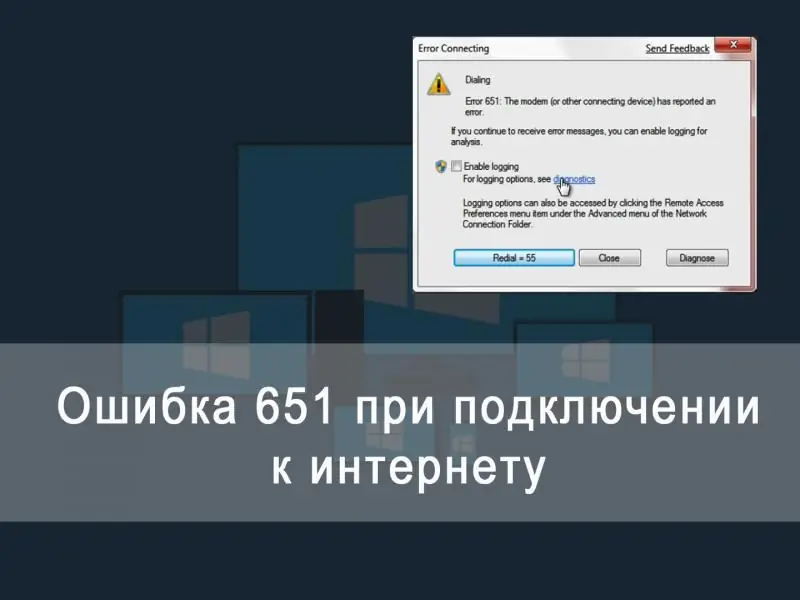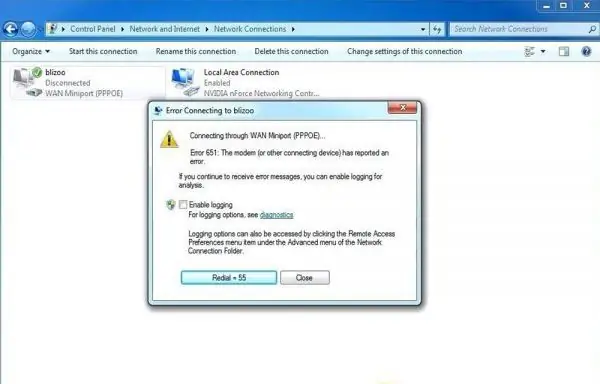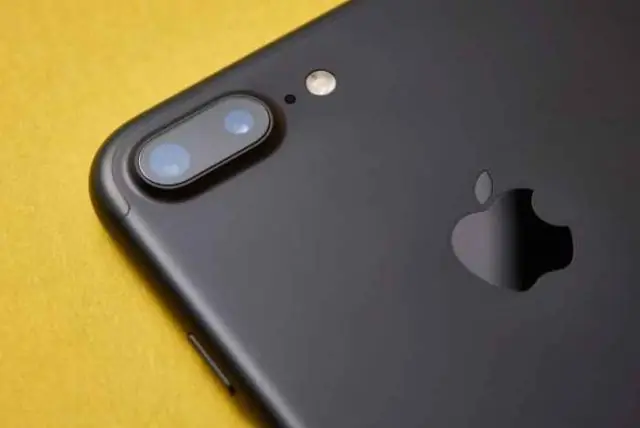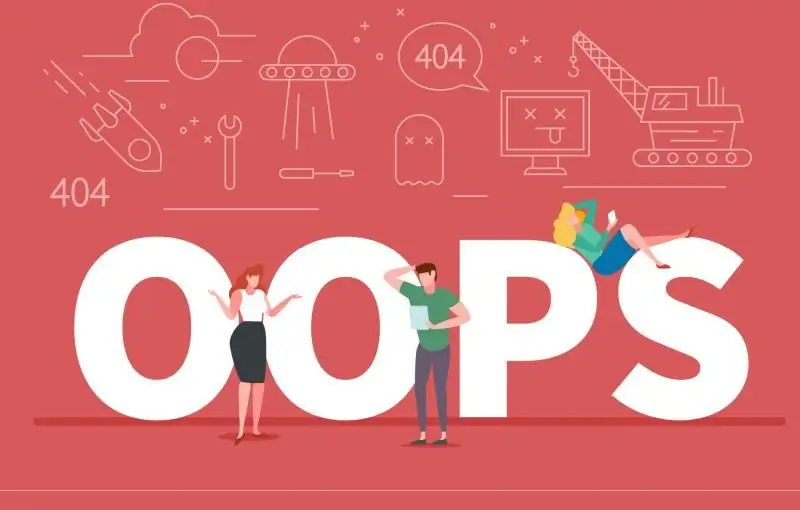
Table of contents:
- Author Bailey Albertson [email protected].
- Public 2023-12-17 12:53.
- Last modified 2025-01-23 12:41.
Error 651: causes and best practices to fix the problem on Windows computers

Sometimes, when trying to connect to the Internet, a warning about access problems appears on the screen, namely error 651. Usually problems of this kind cause software malfunctions, but hardware malfunctions of the computer or network equipment cannot be ruled out. If the problem appears on the part of the provider, then it can be solved by calling the support service. In the event that the telecom operator's specialists were unable to restore access, the cause of the malfunction will have to be looked for independently.
Content
- 1 What causes error 651 and what does it mean
- 2 PPPoE Connection: Simplest Recovery Methods
-
3 Eliminate error 651 in Windows XP, 7, 8, 10
- 3.1 Zeroing with re-setting of network access parameters
- 3.2 Reset TCP / IP parameters
- 3.3 Stopping TCP / IPv6
- 3.4 Reinstalling the network card driver
- 3.5 Restore previous system state
- 3.6 Video: how to fix the situation if the modem or other communication device reported an error
- 4 What to do if a router or modem is involved
What causes error 651 and what does it mean
A pop-up window that informs about the error number 651 indicates that the connection of the computer to the Internet via WAN Miniport via PPPoE protocol failed. If you see such a message, then, most likely, the malfunction appeared due to software failures or unskilled intervention in important sections of the operating system (OS). Much less often, the ERROR: 651 notification appears due to malfunctions of the network equipment involved: an expansion card (Internet adapter), a router (or, in other words, a router) or a modem. In addition, it is imperative to take into account the possibility of damage to the equipment installed by the provider - unfortunately, even expensive professional devices periodically fail.

Error 651 can be caused by a software or hardware failure
The main causes of client-side internet access problems are:
- Connecting a PC to a third-party resource in which the connection to the World Wide Web is limited (blocked).
- Incorrect network connection settings, as well as modification or deletion of system files by malware.
- The RASPPPOE software client, with which the OS creates a high-speed network connection, is working with errors.
- Stopped RAS PPPoE mini-port / call-manager process.
- The PPPoE tunneling protocol connection is blocked by a running antivirus or firewall.
- The network adapter driver is missing or not working correctly.
- Loose or damaged network cables.
- Disruption or breakdown of equipment used to connect to the Network.
If we talk about the problems arising through the fault of the provider, then it is not difficult to solve them - it is enough to contact the technical support specialists by phone, which is specified in the contract for the provision of communication services.
It should be noted that in rare cases, access problems arise for completely unpredictable reasons. Considering myself a person sufficiently savvy in the field of IT technologies, I myself once got into a very unpleasant situation associated with the appearance of the words ERROR: 651. Access to the Network had to be restored immediately, so I immediately used the troubleshooting algorithm known to me. Imagine my surprise when the whole set of measures was unsuccessful. Neither the hardware reconfiguration nor even the replacement of the driver of the used Ethernet adapter helped. Since the situation was aggravated by the fact that the unknown computer had two network cards, it was decided to completely remove the unused expansion card from the PCI slot. Only after that did access to the Network appear. As expected,error 651 was created by a seized interface device - it turned out to be damaged and caused problems in the operation of a working Internet adapter.
PPPoE Connection: Simplest Recovery Methods
When starting to troubleshoot network devices, be sure to consider the way your computer is connected to the Internet - through a modem (router) or directly. However, there is no need to rush with a "deep" search for the source of troubles. Since the solution to the problem most often lies on the surface, the first thing to do is to perform a few simple steps:
- Contact the technical support of your Internet provider and describe the situation. Malfunctions and malfunctions of the provider's professional equipment appear no less often than problems on the subscriber's side. For this reason, it is recommended to start reconfiguring your own system only after you are 100% sure that there are no problems at the opposite end of the wire.
- Reboot the OS. If a router or modem is used to access the Internet, then they must be rebooted, or even restarted altogether. To be completely sure, disconnect the power supply from the mains for at least 5 seconds, and then reconnect to the 220 V.
- Disconnect and reconnect the signal cable connectors that are used to transfer information between the PC, modem or router.
- Error 651, which occurs during the initial setup of home equipment, indicates that incorrect parameters have been entered or the login (password) has been incorrectly written. You should double-check the data and, if necessary, clarify them in the technical support of the service provider.
-
Remember what actions were performed with the computer on the eve of the appearance of the ill-fated message. A recently installed firewall or antivirus might be blocking network access. If such programs were installed, then disable the processes that they create, and try to connect to the Network again.

Login and password for Internet access At the initial setting of the login and password for Internet access, you should carefully double-check the entered data
- When using two or more network adapters, disable unused devices in the network connections menu. Check if the cable is connected to the expansion card that is used to access the World Wide Web.
Often, even following these simple steps is enough to restore the connection to the Network. If, as before, you are unable to access the Internet, then you will need more effective measures.
Eliminating error 651 in Windows XP, 7, 8, 10
Microsoft software developers are constantly working on improving their own operating system, but users have never stopped facing the problem of Internet access under code 651. Despite significant interface differences, the ways to fix this problem are the same for all popular versions of Windows.
Zeroing with re-setting of network access parameters
It makes sense to delete and reconfigure a high-speed connection only when intermediate equipment (modem, router, etc.) is not used to access the Network. An exception is the case when the network switch is used in Bridge mode (network bridge).
If your equipment and the way it is configured meets these requirements, then we suggest doing a few simple steps:
-
Go to the "Network and Sharing Center". To access this menu, click the network connection icon in the tray or run the command control / name Microsoft. NetworkAndSharingCenter.

Go to the network and sharing menu One way to get to the Network and Sharing menu is to enter a special command in the command prompt window
- Review the list of affected connections and determine what causes error 651. Open this line of the list with the right mouse button (RMB) and use the "Delete" command in the pop-up window.
-
To organize a similar connection with updated data, return to the "Network and Sharing Center", and then left-click (LMB) on the line with a proposal to configure a new connection.

Creating a new network connection To create a new connection, you must click on the corresponding link in the "Network and Sharing Center"
- In the window that appears, click the line "Internet connection via PPPoE" and enter the authorization parameters provided by your Internet provider.
If the source of system errors was the incorrect functioning of the PPPoE client RASPPPOE, then after manipulating the removal and reconfiguration of the high-speed connection, the connection will be restored. If the status of the tray icon does not change, then you need to resort to more complex methods of restoring access.
Reset TCP / IP Settings
Sometimes the removal of a high-speed connection does not occur correctly, as a result of which the connection with the Network does not appear. Zeroing all data that the TCP / IP protocol uses can help here. Those readers who do not have the skills to configure the Windows OS will be able to reset the data using the Reset TCPIP program. You can download the distribution kit of this application from the Microsoft website at the link.

The Reset TCPIP program allows you to reset data even if you do not have the necessary experience of interacting with a PC
If you are used to dealing with problems on your own, use a short step-by-step guide.
In Windows XP, 7 or 8, follow these steps:
- Press the combination of buttons Win + X and in the pop-up menu click the line "Run as administrator".
-
Run two commands in order:
- netsh winsock reset;
- netsh int ip reset.
-
Restart your computer and establish a new PPPoE connection according to the algorithm suggested above.

TCP / IP Reset Commands To execute TCP / IP reset commands, you must use the command line
In the top ten, deleting the settings of network protocols and reinstalling Internet adapters is provided at the user interface level - the main thing is that the system has an update 1607. To reset the parameters to factory settings, you will need to do a few simple manipulations:
- Go to the Settings tab available in the Start menu.
- Activate the item "Network and Internet" - it will open on the tab "Status" we need.
-
In the lower part of the window, click on the line "Reset network".

Network reset Network reset in the latest version of Windows is provided in the "Network and Internet" item of the user interface
- Click the "Reset Now" button.
- Confirm your decision by clicking "Yes".
As soon as you make a confirmation click, the network equipment settings will be reset and the computer will restart. After you restore the PPPoE connection parameters, the long-awaited message about the Internet connection will appear in the tray.
Stopping TCP / IPv6
If the previous method did not work, then the problem may have appeared due to a conflict between different data transfer protocols. The solution may be to stop one of them, namely TCP / IPv6.
If you are using one of the earlier versions of Windows, you can change the TCP / IPv6 status on the Properties tab of the network connection you are using. Here's how it's done in XP and Windows 7:
- Enter the Windows function and application management interface (Start button located on the taskbar).
- In the window that appears, go to the "Control Panel".
-
Expand the Network Connections tab.

Network connections in Windows 7 All possible connections to external networks will be shown in the control panel window
- In the window of the Ethernet controller involved, right-click and select the "Properties" tab.
- Browse the list of installed Microsoft components and look for TCP / IPv6.
-
Uncheck the box for activating the data transfer protocol.

Reset panel TCP / IP To prevent conflict between different protocols, unused computer resources must be disabled
In Windows 8, finding the properties menu for a specific network card is a little more difficult:
- Move the mouse pointer to the bottom of the "Desktop" and right-click anywhere on the screen.
- Click on the inscription "All applications" that appears on the right side of the "Desktop".
-
Scrolling to the right of the proposed list of programs, find and open the item "Control Panel".

Control Panel in Windows 8 app list It is necessary to scroll through the list of applications and find the control panel in it
-
In the window that opens, go to the "Network and Internet" tab and open the "View network status" line.

View network status The status of network connections in Windows 8 can be viewed on the "Network and Internet" tab
- Click on the link "Change the settings of network adapters".
-
Click the shortcut of the network card involved and in the window that opens, click the "Properties" button.

List of network connections in Windows 8 Select the adapter used in the list of network connections
- Disable TCP / IPv6 in the same way as with Windows XP and Windows 7.
If among the available network connections there is no item corresponding to the network controller used, then the drivers for this device are not installed.
Reinstalling the network card driver
The driver acts as an intermediary program between the operating system and the components that make up the computer, therefore, has a direct impact on the performance of this or that equipment. You can check if the necessary drivers are installed and if there are any errors in their operation, in the "Device Manager" console. You can run this element and inspect network adapters and other hardware in Windows versions 7, 8 (8.1) and XP as follows:
- Right-click on the "Computer" or "My Computer" icon - you will find it on the "Desktop".
- In the menu that opens, expand the "Control" line.
- Select "Device Manager".
-
Expand the line that lists the network adapters. If a yellow exclamation mark is displayed next to the icon of one of them, then this is direct evidence of a problem with the driver.

Driver error The icon of the problematic Internet adapter in the "Device Manager" is highlighted in yellow and supplemented with an exclamation mark
In the tenth version of Windows, finding "Device Manager" is even easier - just start typing the word "manager" in the search bar and the system will immediately offer several standard applications. All that remains is to select the desired item.
Before taking any further steps, download the latest driver distribution from the network card manufacturer's website. Then proceed according to the following instructions:
- Right click on the selected Ethernet adapter.
- Click on the line "Update driver".
-
In the tab with options for finding drivers, click on the line with the proposal to search for a program on this computer.

Setting the location to search for the driver Since the driver is already in one of the folders on the hard drive, you need to search for it on your computer
- On the page that opens, click the "Browse" button and specify the location where the drivers were written (unzipped).
- After clicking the "Next" button, Windows will start installing or updating drivers, and then notify you that the process was successful.
In some cases, you should update drivers after reinstalling the network adapter. To do this, in the drop-down list (see item 1 of the instructions), instead of "Update driver", select "Remove device". To re-enable the network adapter, right-click on any line and select "Update hardware configuration".
Restore a previous system state
Sometimes the ERROR: 651 message disappears immediately after twitching the cables and restarting the PC and switching devices. In other cases, you have to use all the variety of options. It so happens that none of the methods discussed above have had the desired effect. Then you can use the "last redoubt" - the system recovery service. It is not always possible to "roll back" it to its original state - this requires a restore point.
To use the Windows 7 or XP Recovery Wizard, you need to follow a few simple steps:
- Go to the start menu.
- Sequentially select "All Programs" - "Standard" - "Utilities".
-
In the context menu, select the "System Restore" item.

System Restore in Windows XP The item "System Restore" is in the menu "All Programs" - "Standard" - "System Tools"
-
After determining the point in time to which you want to rollback, click on the required line with the left mouse button.

System Restore In order to roll back the system to its previous state, you need a restore point
- Click "Next", "Finish" and confirm your decision by clicking "Yes".
The system will replace the system files with their earlier versions and, after rebooting, will notify the completion of the process.
Using the restore feature in Windows 8 is just as easy:
- Press the Win + C key combination.
- Select Options.
- Click on the line with a proposal to change the computer settings and select "Update and recovery".
-
In the window that appears, open "Restore your computer without deleting files."

Restoring a computer in Windows 8 The latest Windows recovery panel has a more user-friendly interface
- Activate the button "Start", then "Next" and "Update". System restore will start immediately - the process will be similar to the case with Windows 7.
You can restore the tenth version of Windows to its original state through the system properties window, which is launched through the "Control Panel". In the "Recovery" tab, click "Start System Restore". Further actions should be performed in the same way as we did in XP and the "seven". After returning the OS to its original state, the annoying 651 error window will disappear.
Video: how to fix the situation if the modem or other communication device reported an error
What to do if a router or modem is involved
We have already said above that the PPPoE connection from the PC will start only when the router or modem is in Bridge mode. In another case, it is pointless to configure high-speed access settings on a PC - the router will itself make connection attempts without passing data packets from the computer.
To view and adjust the settings of the modem or router, you need to go to the device's web interface:
- In the address bar of the browser, enter 192.168.1.1 or 192.168.0.1 - these addresses open access to the control panel of network peripheral devices.
- In the window that appears, enter the access parameters. The alphabetic combinations admin or root are most often used as the standard login and password. The manufacturer prints the exact access parameters on a sticker located on the bottom of the modem or router.
- Open the PPPoE connection settings menu by moving to the Internet or WAN tab.
-
Enter the information provided by your service provider. Be sure to check the Connect Automatically checkbox to enable automatic connection mode.

Setting up a router To configure the router, you will need the data that the provider must provide
- Save the settings by clicking the Save or Accept button.
After saving the settings, the router will distribute Internet access to all devices connected to it.
When using an ADSL modem, make sure the Link or DSL LED is stable. In addition, the VPI and VCI parameters must be specified as this pair of values is used to identify the communication channels. This data is also provided by the provider.
As you can see, there are many reasons why a high-speed Internet connection is not established. Unfortunately, this is not a complete list - we have considered only the most common problems and methods of solving them. Perhaps you had to deal with some unusual situation or an extraordinary way to restore the connection of a PC to the Network via PPPoE. We will be glad if you share interesting information with other readers in the comments.
Recommended:
There Was An Error Connecting To The Apple ID Server, Failed Verification, Creation, And Other Apple ID Errors

How to fix Apple server connection error. What to do if you fail to create or verify your Apple ID. Detailed step-by-step instructions
The Network Cable Is Not Connected: Possible Causes Of The Error And How To Solve It

Checking the network cable, the main causes of connection problems and their solution: hardware problems, driver and settings of the network card
Error While Allowing Internet Connection Sharing (null): Causes And Solutions

Because of which, "Error while allowing Internet Connection Sharing (null)" may occur. How to solve the problem: Turn on Windows Firewall
Error 691 When Connecting To The Internet: Causes And Solutions

Why can I get error 691 while connecting to the Internet. How to fix the situation: we apply effective methods
Error 633 (modem In Use Or Not Configured) On Windows 10: Causes And Solutions

For what reasons can error code 633 occur: from a simple failure to installing the Creators Update. How to quickly solve a connection problem
